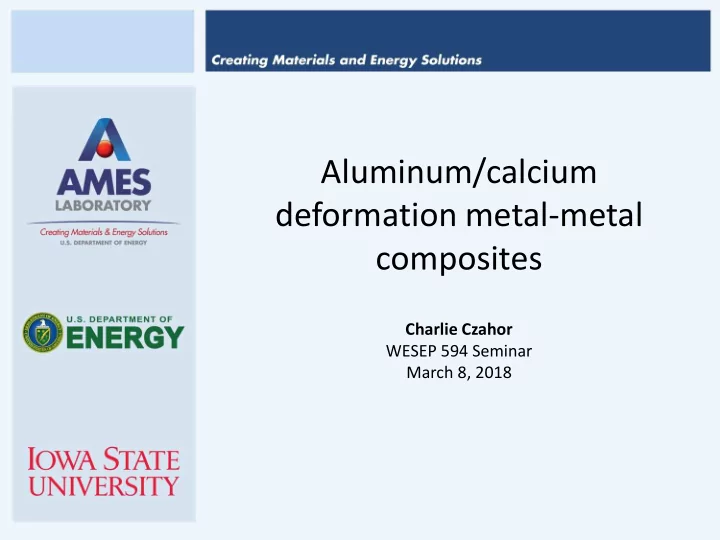

Aluminum/calcium deformation metal-metal composites Charlie Czahor WESEP 594 Seminar March 8, 2018
Overview • Background and Motivation • Sample Preparation • Recent Results – Microstructure/Conversion – Conductivity – Tensile Strength • Prospects for Installation • Conclusions and Future Work 2 E. Morhardt , “Power Transmission: the Rise of the Supergrid ”, The Economist , 2017, pp. 71-72.
Background and Motivation • Objective : Develop cost competitive, lightweight, high strength, high conductivity material for overhead power transmission. • Increasing renewable generation capacity in remote areas requires long distance transmission to reach population centers. • High voltage direct current (HVDC) is the preferred technology for long distance transmission. 3
Current High Voltage Conductor Designs • Aluminum Conductor Steel Reinforced (ACSR) • All Aluminum Alloy Conductor (AAAC) • Aluminum Conductor Composite Core (ACCC) • Aluminum Conductor Composite Reinforced (ACCR) • Aluminum Conductor Aluminum-Alloy Reinforced (ACAR) ACCR AAAC ACSR ACAR ACCC 4 ACSR catalog, 2012, Southwire, Carrollton, GA.
An Alternative Approach • Deformation Metal-Metal Composites (DMMCs) can achieve both high strength and high conductivity. • DMMCs utilize ductile metals in both the matrix and reinforcement phase. 50 µm • Extensive deformation allows filaments to reach sub-micron level. • High strength with no steel core . Unconverted Converted Al/Ca 11.5 vol. % Al/Al 2 Ca 18 vol. % Conductivity Density Element Cost (g/cm 3 ) (IACS) Aluminum 61.0 Low 2.7 Calcium 48.7 Medium 1.5 5 Alan Russell, Scott Chumbley, Yu Tian, Adv. Engr. Matl., 2 (2000) 11-22.
Sample Preparation High purity fine High purity Blended powder Extrusion can atomized Ca atomized Al compact loaded with (11.5 vol. %) (88.5 vol. %) compacts Indirect Extrusion E-beam welding 6
Electrical Conductivity 36 • Close to rule of mixtures value at 35 low strain 34 Conductivity (µΩm -1 ) • Drop in Unconverted 33 conductivity at high Converted strain from 32 11.5% Ca ROM scattering at 18% Al₂Ca ROM 31 interfaces • Conversion to Al 2 Ca 30 surprisingly has 29 little effect 6 7 8 9 10 11 12 13 True Strain 7
Ultimate Tensile Strength • Hall-Petch 500 strengthening Al/Ca 11.5% Al/Ca 11.5% Hall-Petch Al/Al₂Ca 18% Al/Al₂Ca 18% Hall -Petch 450 with smaller ACSR ACCC ACCR ACAR 400 filament size 350 • Al 2 Ca reinforced 300 UTS (MPa) wire stronger for 250 all sizes 200 Filament Thickness 150 Unconverted 100 50 Converted 0 6 7 8 9 10 11 12 13 14 True Strain 8
Comparison to Existing Conductors • Specific strength as great as two times 150 Al/Al2Ca 18% ACSR that of ACSR Specific Strength (kPa m 3 kg -1 ) ACAR 130 ACCR • Able to tailor ACCC composite 110 properties for a specific application 90 • Modified properties 70 with monolithic construction 50 50 52 54 56 58 60 Electrical Conductivity (%IACS) 9
Potential Savings Using Al/Al 2 Ca Composites Design Parameters Scenario Constant with base case Varied Conductor Cross Section 1171 mm 2 ACSR As built As built Voltage ±500 kV Tower spacing and weight Case 1 Conductor Size Rated Power 3100 MW per tower Number of Towers 4200 Case 2 Losses and weight per Tower spacing and tower Conductor Size Current 3100 A Case 1 -12.4% Case 2 -11.1% ACSR ACSR 0 500 1000 1500 0 1000 2000 3000 4000 5000 First Year Losses (GWh) Number of Towers 10
Ongoing and Future Work • Development of gas-phase passivation for use during atomization of Ca powder. • Enabling industrial production of high purity Al powder. • Commercial extrusion sample for size conductor testing 11
Conclusions • Metal-metal composites have potential to be used as overhead conductors. • Converted Al/Ca composite were produced with high strength, high electrical conductivity, and low density. • Weigh reduction and high strength can increase tower spacing . • Several steps remain to move technology forward. 12
Acknowledgements Al/Ca Wire Team Ames Lab Powder Group Trevor Riedemann Dr. Iver Anderson Dr. Iver Anderson Ross Anderson Dr. Alan Russell Dave Byrd Stephanie Choquette Aaron Kassen Emily Rinko Tim Prost Trevor Riedemann DE-AC02-07CH11358 Jordan Tiarks Stacey Trytek Other Contributors Dr. Emma White Extrusion: Soren Mueller-(TU Berlin) Tensile Testing: Charles Spellman (Psylotech), Matt Besser(Ames Lab) Conductivity: Gaoyuan Ouyang (Ames Lab) 13
Recommend
More recommend